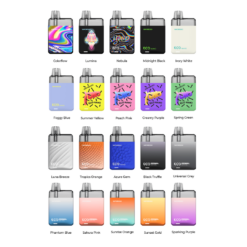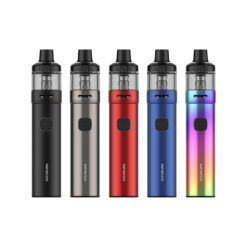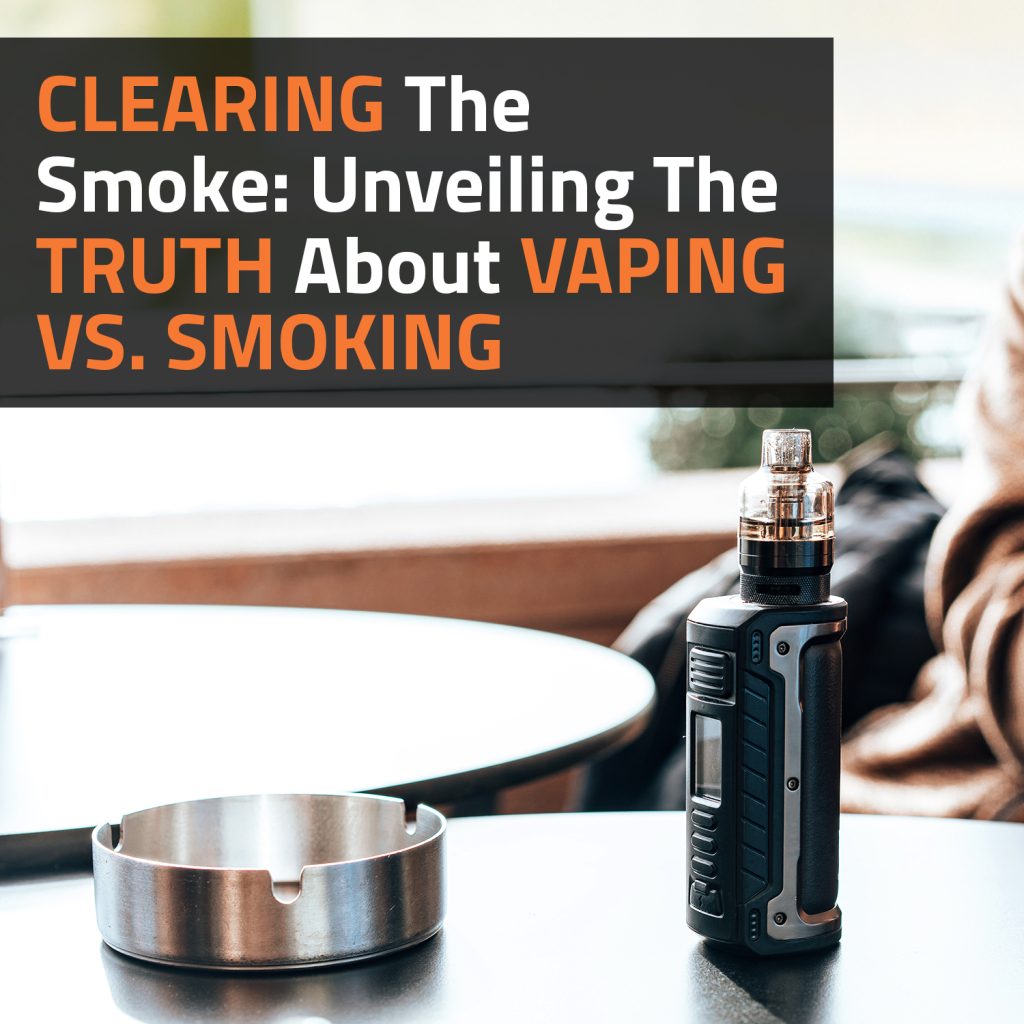In today’s world of complex nicotine choices, the vaping vs. smoking debate takes the spotlight. Tradition meets innovation, combustion meets aerosolisation, and millions are left curious yet confused.
In this exploration, we aim to dispel the cloud of misinformation surrounding these topics. This article is your guide through the maze of health, ingredients, addiction, public perception, and evolving regulations.
Whether you’re a lifelong smoker contemplating change or just curious about its science and culture, get ready to uncover the unvarnished truth about vaping vs. smoking. This journey equips you with the knowledge to make informed decisions about your well-being.
-
Vaporesso ECO NANO Kit
R295.00Original price was: R295.00.R195.00Current price is: R195.00. -
UWELL Caliburn X Pod System
R625.00Original price was: R625.00.R399.00Current price is: R399.00. -
Uwell Caliburn A3 Pod Kit
R450.00Original price was: R450.00.R300.00Current price is: R300.00. -
Vaporesso GTX GO 40 Kit
R395.00
The Rising Debate
The ongoing debate between vaping and smoking has captured the attention of millions worldwide. It’s a clash of modern alternatives versus age-old traditions, and the stakes couldn’t be higher. As society becomes more health-conscious, individuals are increasingly questioning the choices they make concerning nicotine consumption. The vaping vs. smoking debate is at the heart of this transformation, and it’s time to dissect the arguments on both sides.
Before we dive into the specifics of vaping and smoking, it’s essential to understand the key players in this showdown. Smoking, rooted in centuries of history, has held a dominant position in the nicotine world. In contrast, vaping, a relatively recent invention, presents itself as a disruptive challenger. Both have their unique characteristics, and to make an informed decision, you need to know what they bring to the table.
Health Implications Of Vaping Vs. Smoking
When it comes to health implications, both smoking and vaping have starkly contrasting stories to tell.
Smoking: The Legacy Of Harm
Smoking, known as the traditional and more established method of nicotine consumption, carries a legacy of harm that spans centuries.
Smoking is synonymous with combustion, a process that turns tobacco into a cloud of toxic chemicals. The act of burning tobacco produces tar, carbon monoxide, and thousands of other harmful substances. These chemicals, when inhaled, wreak havoc on the respiratory system. Tar, for instance, coats the lungs, impairs their function, and is a primary contributor to lung cancer. Carbon monoxide, on the other hand, reduces the blood’s ability to carry oxygen, straining the heart and leading to cardiovascular diseases.
The consequences of smoking are far-reaching, leading to a host of debilitating diseases. Lung cancer is perhaps the most notorious, but smoking is also linked to throat, mouth, oesophagus, and bladder cancers. Additionally, it significantly increases the risk of heart disease, stroke, chronic obstructive pulmonary disease (COPD), and respiratory infections. The legacy of harm left by smoking is extensive and well-documented, making it a significant public health concern.
Vaping: A Lesser Evil?
On the other hand, vaping, considered by many as a potentially less harmful alternative, raises questions about its health implications.
Vaping has been heralded as a harm reduction tool, offering smokers an alternative to combustible cigarettes. Advocates argue that by eliminating combustion, vaping reduces exposure to harmful chemicals found in tobacco smoke. While there’s evidence to suggest that vaping is less harmful than smoking, it’s important to note that it’s not entirely risk-free. The long-term health effects are still being studied, and concerns about vaping’s impact on respiratory health persist.
Emerging health concerns, such as vaping-associated lung injuries and concerns about the safety of certain e-liquid ingredients, have raised questions about its long-term safety. It’s essential to delve into these concerns and understand that while vaping might offer a path away from smoking, it is not devoid of potential risks.
Ingredients And Mechanisms
Understanding the ingredients and mechanisms behind smoking and vaping is crucial in assessing their potential health impacts.
Smoking: Unveiling the Culprits
To understand the harmful nature of smoking, it’s crucial to explore the components of tobacco. Tobacco leaves contain nicotine, a highly addictive substance, as well as tar and countless chemicals, many of which are carcinogenic. These chemicals, when ignited, form the toxic cocktail that smokers inhale, causing extensive damage to their bodies.
Vaping: The Science Behind It
Vaping relies on e-liquids, typically consisting of nicotine, propylene glycol, vegetable glycerin, and flavourings. While these ingredients are generally considered safe for consumption, questions linger about the safety of inhaling them when heated and vaporised. The specific composition of e-liquids can vary widely, adding complexity to the safety assessment.
Vaping also operates on a fundamentally different principle from smoking. Instead of combustion, it involves the vaporisation of e-liquids at lower temperatures. Understanding the science behind this vaporisation process is crucial to grasp why vaping is considered a less harmful alternative to smoking.
Addiction And Nicotine
Nicotine addiction is at the core of the smoking and vaping debate, with significant implications for individuals trying to quit.
Smoking: Nicotine’s Tight Grip
Nicotine, the primary addictive substance in tobacco, exerts a powerful grip on the brain. It stimulates the release of dopamine, creating a sense of pleasure and reinforcing the desire to smoke. This neurological mechanism contributes significantly to the difficulty of quitting smoking.
Quitting smoking often leads to a range of withdrawal symptoms, including irritability, anxiety, cravings, and even depression. Understanding these symptoms is crucial for those attempting to break free from nicotine addiction.
Vaping: A Smoking Cessation Tool?
Vaping has gained attention as a potential smoking cessation tool. It allows smokers to gradually reduce their nicotine intake while still satisfying their cravings. Although the effectiveness of vaping as a cessation method remains a subject of debate and study, most results have proven that making the switch to vaping proves to be the most effective way to quit smoking.
Public Perception And Regulation
The perception of smoking and vaping within society, along with the regulations governing them, plays a significant role in shaping individual choices and public health outcomes.
Smoking: The Stigma And Restrictions
Anti-smoking campaigns have played a pivotal role in shaping public perception of smoking. They highlight the dangers of smoking, increase awareness, and promote cessation. These campaigns have contributed to the declining social acceptability of smoking.
Furthermore, the introduction of smoking bans in public places has further restricted where smokers can indulge in their habit. Understanding the reasons behind these bans and their impact on smokers and non-smokers alike are essential for appreciating the changing landscape of smoking.
Vaping: The Ambiguous Status
The regulatory landscape for vaping is still evolving. Understanding the current regulations, including age restrictions, advertising restrictions, and product safety standards, is crucial to grasp how vaping is being managed by authorities.
Vaping has given rise to a unique subculture with its own set of norms and practices. Examining this vaping culture sheds light on the appeal of vaping to different demographic groups and the challenges of regulating this emerging phenomenon.
Weighing The Options
After a thorough exploration of the vaping vs. smoking showdown, it’s time to weigh the options. Consider the health implications, the ingredients and mechanisms at play, the addictive nature of nicotine, public perception, and the evolving regulatory landscape. Each factor plays a role in the decision-making process.
Ultimately, the choice between vaping and smoking is a personal one. Armed with a comprehensive understanding of the factors at play, you can make informed choices that align with your health goals and values. Remember that seeking support from healthcare professionals is always a wise step when dealing with nicotine addiction or transition. The showdown continues, but you have the knowledge to navigate it wisely.










